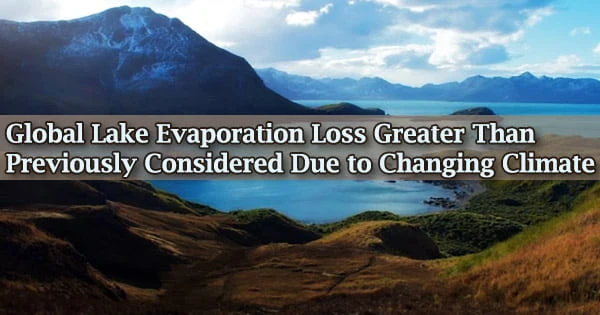Just east of Las Vegas, near the Nevada-Arizona border, a white mineral ring as tall as the Statue of Liberty climbs along the rocky shores of Lake Mead, a Colorado River reservoir. The largest reservoir in the nation is fast depleting.
It is crucial that those making decisions about water management have reliable information because a large portion of the country is experiencing above-normal temperatures, below-average rainfall, and a changing environment.
The global lake evaporation volume (GLEV) dataset was developed by researchers under the direction of Dr. Huilin Gao, associate professor in the Zachry Department of Civil and Environmental Engineering at Texas A&M University. The first long-term monthly time series for the 1.42 million unique natural lakes and artificial reservoirs worldwide is provided by combining modeling and remote sensing.
The study’s findings were reported in Nature Communications. Lakes, both natural and man-made (i.e., reservoirs), hold about 87 percent of fresh surface water in liquid form.
Despite the considerable amount of evaporation from these global lakes, little is known about their spatial distribution and long-term trend. Long-term average lake evaporation volume has increased by 3.12 cubic kilometers a year from 1985 to 2018, according to studies.
The trend attributions consist of a 58 percent increase in evaporation rate, a 23 percent decrease in lake ice covering, and a 19 percent increase in lake surface area. The study’s findings highlight the significance of utilizing evaporation volume as the main criterion to evaluate climate influences on lake systems rather than evaporation rate.
“We found that the long-term lake evaporation is 1500 plus or minus 150 cubic kilometers per year, which is 15.4% larger than previous estimates,” said first author Dr. Gang Zhao, a Texas A&M former student who is now a postdoctoral fellow in the Department of Global Ecology at the Carnegie Institute for Science. “This suggests that lake evaporation plays a larger role in the hydrological cycle than previously thought.”
GLEV estimates that 6,715 reservoirs only hold 5% of the world’s total lake surface area and 10% of its total water storage capacity (both natural and artificial).
We found that the long-term lake evaporation is 1500 plus or minus 150 cubic kilometers per year, which is 15.4% larger than previous estimates. This suggests that lake evaporation plays a larger role in the hydrological cycle than previously thought.
Dr. Gang Zhao
However, 16% of the evaporation volume comes from reservoirs. This amount of reservoir evaporative loss is equal to 20% of the world’s annual water usage. Evaporative water loss from reservoirs has risen by 5.4 percent annually over the past 33 years, surpassing the global trend of 2.1 percent for all lakes.
“With regard to evaporation loss, this study will be an invaluable venue to serve water resources researchers and decision-makers,” Gao said. “Our findings have significant environmental, societal and economic implications as the global evaporative loss will be accelerated and further exacerbated in the future under global warming.”
“From a global perspective, the total reservoir evaporation can be larger than the combined use of domestic and industrial water. However, even in the United States, very few lakes/reservoirs have reliable evaporation data.”
Reliable estimates of the availability of water and energy resources, according to academics, cannot be established without precisely determining the quantity and pattern of volumetric evaporation loss for each of the millions of global lakes. The wider scientific community, as well as decision-makers, can gain from this freely accessible resource.
“With results for individual water bodies, GLEV can really help improve reservoir management decision-making all over the world, especially under increasing drought events and population growth,” Gao said.
“This dataset helps the science community better understand the role that these water bodies play in Earth systems, from global weather forecasting, flood and drought modeling to Earth system modeling under climate change.”
In order to produce operational, daily reservoir evaporation monitoring and forecasts for the Western United States, Texas A&M researchers, the Desert Research Institute, and the U.S. Bureau of Reclamation recently began a roughly $1 million NASA Applied Science project. The group will also broaden a daily reservoir monitoring effort for Texas that is already in place.
Dr. Liming Zhou, a professor in the department of atmospheric and environmental sciences at The State University of New York, and Dr. Yao Li, a postdoctoral research fellow in the civil and environmental engineering department at Texas A&M, are other authors on this study.
NASA, the Department of Energy and the National Science Foundation fund this research.
















